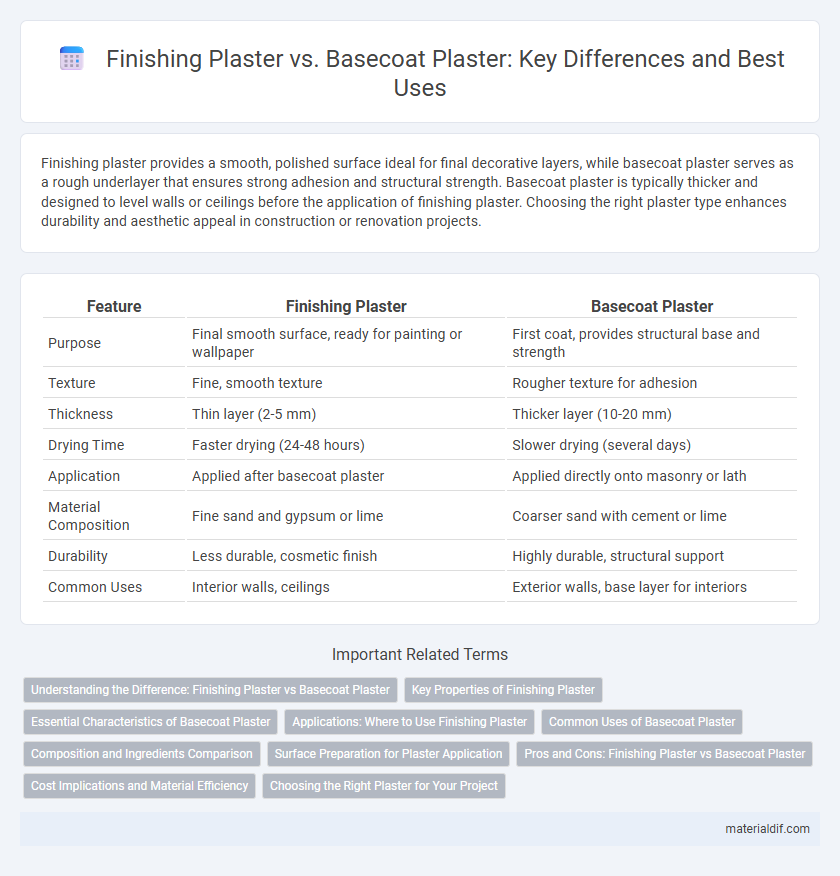Finishing plaster provides a smooth, polished surface ideal for final decorative layers, while basecoat plaster serves as a rough underlayer that ensures strong adhesion and structural strength. Basecoat plaster is typically thicker and designed to level walls or ceilings before the application of finishing plaster. Choosing the right plaster type enhances durability and aesthetic appeal in construction or renovation projects.
Table of Comparison
| Feature | Finishing Plaster | Basecoat Plaster |
|---|---|---|
| Purpose | Final smooth surface, ready for painting or wallpaper | First coat, provides structural base and strength |
| Texture | Fine, smooth texture | Rougher texture for adhesion |
| Thickness | Thin layer (2-5 mm) | Thicker layer (10-20 mm) |
| Drying Time | Faster drying (24-48 hours) | Slower drying (several days) |
| Application | Applied after basecoat plaster | Applied directly onto masonry or lath |
| Material Composition | Fine sand and gypsum or lime | Coarser sand with cement or lime |
| Durability | Less durable, cosmetic finish | Highly durable, structural support |
| Common Uses | Interior walls, ceilings | Exterior walls, base layer for interiors |
Understanding the Difference: Finishing Plaster vs Basecoat Plaster
Finishing plaster provides a smooth, refined surface ideal for painting or wallpapering, while basecoat plaster is applied as a thicker, rougher layer to level walls and provide a solid foundation. Basecoat plaster contains more aggregates to enhance strength and durability, whereas finishing plaster is finer and easier to sand for a polished finish. Understanding the distinct roles and compositions of each type ensures optimal application and long-lasting, high-quality wall surfaces.
Key Properties of Finishing Plaster
Finishing plaster is characterized by its fine texture, smooth application, and quick drying time, making it ideal for creating a polished surface ready for painting or wallpapering. Its key properties include excellent adhesion, minimal shrinkage, and a composition rich in fine gypsum or lime, which enhances durability and aesthetic appeal. Unlike basecoat plaster, finishing plaster is applied in thin layers that are easier to sand and shape, providing a refined finish essential for interior wall surfaces.
Essential Characteristics of Basecoat Plaster
Basecoat plaster is essential for providing a strong, durable foundation that adheres well to masonry or drywall surfaces, ensuring structural integrity. Its coarser texture and thicker application make it ideal for leveling uneven walls or ceilings before the final finishing plaster is applied. Moisture resistance and flexibility are key characteristics that help prevent cracking and improve long-term stability in various interior environments.
Applications: Where to Use Finishing Plaster
Finishing plaster is primarily used on interior walls and ceilings to create a smooth, polished surface ready for painting or wallpapering. It is ideal for residential and commercial spaces that require a flawless, decorative finish. Unlike basecoat plaster, which provides structural strength and thickness, finishing plaster focuses on aesthetic appeal and is applied as the final coat.
Common Uses of Basecoat Plaster
Basecoat plaster is primarily used as the foundational layer in wall construction, providing a strong, durable surface that adheres well to brick, block, or masonry substrates. It offers excellent moisture resistance and allows for minor surface leveling before the application of finishing plaster. Common uses include preparing walls for finishing coats in residential, commercial, and industrial buildings to ensure smooth, crack-free surfaces.
Composition and Ingredients Comparison
Finishing plaster typically contains fine aggregates, gypsum, and polymers, providing a smooth, durable surface ideal for final coats, while basecoat plaster is composed of coarser aggregates like sand, lime, and cement to ensure strong adhesion and structural support. The higher gypsum content in finishing plaster enhances workability and gives a polished appearance, whereas the lime and cement in basecoat plaster contribute to strength and moisture resistance. These distinct compositions address different stages in plaster application, with basecoat forming the substrate and finishing plaster delivering the aesthetic final finish.
Surface Preparation for Plaster Application
Finishing plaster requires a meticulously prepared surface that is smooth, clean, and free from dust, grease, or loose particles to ensure optimal adhesion and a flawless final appearance. Basecoat plaster demands a rough, keyable substrate often achieved by scoring or using a bonding agent to provide a strong mechanical grip for the subsequent plaster layers. Proper surface preparation, including priming when necessary, is critical to prevent issues like cracking, delamination, or uneven drying during plaster application.
Pros and Cons: Finishing Plaster vs Basecoat Plaster
Finishing plaster offers a smooth, polished surface ideal for final wall treatments but requires skilled application and is more prone to cracking if improperly applied. Basecoat plaster provides a thicker, more robust layer that enhances structural strength and adhesion for finishing coats, yet it lacks aesthetic qualities needed for visible surfaces. Selecting between finishing plaster and basecoat plaster depends on the balance between surface smoothness and foundational durability in construction projects.
Cost Implications and Material Efficiency
Finishing plaster typically incurs higher costs due to its finer texture and smoother application, making it ideal for visible surfaces, whereas basecoat plaster offers greater material efficiency by providing a thicker, more robust layer at a lower price point. The choice between finishing and basecoat plaster directly impacts overall project expenses, with finishing plaster requiring additional labor time and premium materials that increase costs. Opting for basecoat plaster in underlying layers maximizes durability and cost-effectiveness, allowing finishing plaster to be applied sparingly where aesthetics are crucial.
Choosing the Right Plaster for Your Project
Finishing plaster provides a smooth, fine surface ideal for painting or wallpapering, while basecoat plaster serves as a strong, durable foundation layer that ensures structural integrity. Selecting the right plaster depends on the project requirements, such as surface finish quality and wall strength, with basecoat plaster applied first followed by finishing plaster for optimal results. Using the correct plaster combination enhances durability and aesthetics, reducing cracks and improving overall wall performance.
Finishing Plaster vs Basecoat Plaster Infographic

 materialdif.com
materialdif.com